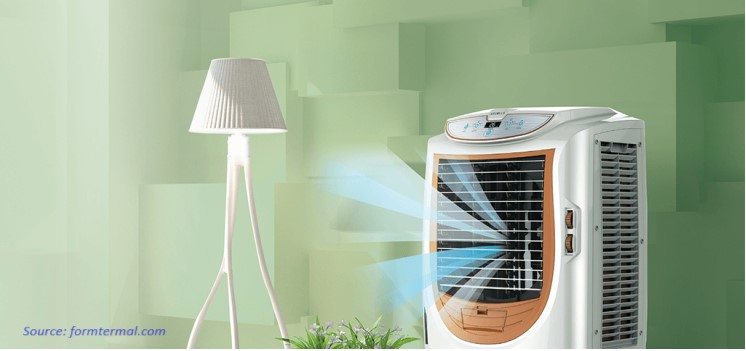
India Heat Exchangers Market by Type (Shell & Tube, Plate & Frame, Air Cooled, and Others), by Material (Metals, Alloys, and Brazing-CLAD), and by End User (Chemical, Energy & Power, Heating, Ventilation, Air Conditioning, and Refrigeration (HVACR), Food & Beverage, Pulp & Paper, and Others)– Opportunity Analysis and Industry Forecast, 2024–2030
Industry: Retail and Consumer | Publish Date: 22-Mar-2024 | No of Pages: 118 | No. of Tables: 86 | No. of Figures: 51 | Format: PDF | Report Code : N/A
Market Overview
The India Heat Exchangers Market size was valued at USD 1384.2 million in 2023, and is predicted to reach USD 3102.0 million by 2030, with a CAGR of 11.5% from 2024 to 2030.
Heat exchangers, devised to transfer heat between fluids without direct contact, find extensive application across industrial, commercial, and residential domains, notably in HVAC systems and refrigeration units for efficient fluid or air conditioning. Functioning by enabling heat transmission through barriers such as solid walls or arrays of plates or tubes, they serve diverse purposes such as heating water in boilers or cooling air in air conditioning units. Available in varied designs tailored to specific requirements, they range from simple radiator coils to intricate systems deployed in chemical processing plants and power generation facilities.
These devices play indispensable roles across multiple industries and applications, regulating air temperatures in buildings, facilitating steam generation in power plants, managing temperatures during chemical reactions, and aiding in food processing, among others. Additionally, they serve as critical components in automotive cooling systems and boast wide-ranging applications in aerospace, marine, and wastewater treatment sectors, where they play pivotal roles in efficient thermal management and energy transfer.
Growing Industrialization and Urbanization across India drive market growth
The rapid escalation of industrialization and urbanization globally emerges as a pivotal driver propelling the expansion of the heat exchangers market. As manufacturing, energy, and construction sectors undergo expansion, there emerges an escalating demand for effective heat exchange solutions to cater to diverse industrial needs.
Sectors such as power generation, wherein heat exchangers assume critical roles in steam generation and turbine cooling, witness notable growth propelled by increasing energy demands. Moreover, this upsurge triggers a surge in construction ventures, consequently heightening the requirement for HVAC systems in both commercial and residential establishments. Consequently, there is a heightened need for heat exchangers in applications pertaining to air conditioning and refrigeration.
Stringent Government Regulations in India Regarding Energy Efficiency Boost Market Expansion
The surge in regulations aimed at enhancing energy efficiency and curbing emissions arises from a heightened awareness of the environmental impact associated with industrial operations. Governments and regulatory bodies in India are enforcing stringent standards such as India's Energy Conservation Act and the US Energy Policy Act to address climate change and promote sustainable practices.
Consequently, industries are increasingly adopting heat exchangers to optimize energy utilization and diminish their carbon footprint. Among these sectors, the chemical industry emerges as the foremost consumer of heat exchangers, constituting over 30% of the global market share.
Embracing these energy-efficient technologies enables industries to adhere to regulatory mandates and contribute to a greener future by mitigating greenhouse gas emissions and conserving natural resources. Thus, the escalating adoption of heat exchangers signifies a notable shift towards environmentally conscious practices across industrial sectors.
High Installation and Maintenance Costs Restrain Market Growth
Significant factors hindering the growth of the heat exchangers market include high initial costs and ongoing maintenance expenses. The considerable investment needed for acquiring and installing heat exchangers, especially in large-scale industrial applications, deters companies, particularly those with constrained financial resources, from embracing this technology.
Moreover, despite offering long-term cost savings through enhanced energy efficiency, heat exchangers entail regular maintenance and operational expenses, such as cleaning and repairs. Consequently, the perceived financial burden associated with heat exchangers may serve as a barrier to their widespread adoption, thereby impeding market growth in specific sectors.
Integration with Renewable Energy Systems Creates a Market Opportunity
Integration with renewable energy systems presents a market opportunity in the heat exchangers market by facilitating the efficient transfer and utilization of thermal energy generated from renewable sources. Heat exchangers play a crucial role in renewable energy systems such as solar thermal collectors, geothermal heat pumps, and biomass boilers by capturing and transferring heat for various applications.
As the demand for renewable energy continues to rise globally, there is a growing need for heat exchangers to optimize energy conversion processes and enhance system efficiency. This integration not only expands the application scope of heat exchangers but also contributes to the transition towards sustainable energy solutions, driving market growth in the renewable energy segment.
Competitive Landscape
Several market players operating in India’s heat exchangers market include Alfa Laval AB, Johnson Controls International plc, Carrier Global Corporation, Lennox International Inc., Trane Technologies plc, API Heat Transfer Inc., Kelvion Holding GmbH, Xylem Inc., Danfoss Group, and General Electric Company among others. These companies are adopting various strategies such as product launches to remain dominant in the heat exchangers market.
Key Market Segments
By Type
-
Shell & Tube
-
Fixed Tube Heat Exchangers
-
U-Tube Heat Exchangers
-
Floating Head Heat Exchangers
-
Other Shell & Tube Heat Exchangers
-
-
Plate & Frame Heat Exchangers
-
Gasketed Plate & Frame Heat Exchangers
-
Welded Plate & Frame Heat Exchangers
-
Brazed Plate & Frame Heat Exchangers
-
Other Plate & Frame Heat Exchangers
-
-
Air Cooled
-
Forced Draft Heat Exchangers
-
Induced Draft Heat Exchangers
-
-
Others
By Materials
-
Metals
-
Alloys
-
Brazing-CLAD
By End User
-
Chemical
-
Energy & Power
-
HVACR
-
Food & Beverage
-
Pulp & Paper
-
Others
REPORT SCOPE AND SEGMENTATION:
|
Parameters |
Details |
|
Market Size in 2023 |
USD 1384.2 Million |
|
Revenue Forecast in 2030 |
USD 3102.0 Million |
|
Growth Rate |
CAGR of 11.5% from 2024 to 2030 |
|
Analysis Period |
2023–2030 |
|
Base Year Considered |
2023 |
|
Forecast Period |
2024–2030 |
|
Market Size Estimation |
Million (USD) |
|
Growth Factors |
|
|
Companies Profiled |
10 |
|
Market Share |
Available for 10 companies |
|
Customization Scope |
Free customization (equivalent up to 80 working hours of analysts) after purchase. Addition or alteration to country, regional, and segment scope. |
|
Pricing and Purchase Options |
Avail customized purchase options to meet your exact research needs. |
KEY PLAYERS
-
Alfa Laval AB
-
Johnson Controls International plc
-
Carrier Global Corporation
-
Lennox International Inc.
-
Trane Technologies plc
-
API Heat Transfer Inc.
-
Kelvion Holding GmbH
-
Xylem Inc.
-
Danfoss Group
-
General Electric Company




 Speak to Our Analyst
Speak to Our Analyst


































